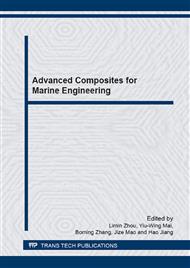[1]
X.H. Chen, J. Lu, K. Lu, etc, Tensile properties of a nanocrystalline 316L austenitic stainless steel, Scripta Mater. 52 (2005)1039-1044.
DOI: 10.1016/j.scriptamat.2005.01.023
Google Scholar
[2]
L. Waltz, D. Retraint, A. Roos, P. Olier, and J. Lu, Publicated by Trans Tech Pubilications Ltd, Switzerland, 2009, pp.249-254.
Google Scholar
[3]
L. Waltz, D. Retraint, A. Roos and P. Olier, Combination of surface nanocrystallization and co-rolling: Creating multilayer nanocrystalline composites, Scripta. Mater. 60 (2009) 21-24.
DOI: 10.1016/j.scriptamat.2008.08.024
Google Scholar
[4]
A.Y. Chen, D.F. Li, J.B. Zhang, H.W. Song and J. Lu, Make nanostructured metal exceptionally tough by introducing non-localized fracture behaviors, Scripta Mater. 59 (2008) 579-582.
DOI: 10.1016/j.scriptamat.2008.04.048
Google Scholar
[5]
X.C. Zhang, J. Lu, and S.Q. Shi, Mech. Adv. Mater. Struc. 18 (2011) 572–577.
Google Scholar
[6]
X. Guo, A.Y.T. Leung, A.Y. Chen, H.H. Ruan, J. Lu, Investigation of non-local cracking in layered stainless steel with nanostructrued interface. Scripta. Mater. 63 (2010) 403–406.
DOI: 10.1016/j.scriptamat.2010.04.035
Google Scholar
[7]
G.I. Barenblatt, On equilibrium cracks formed in brittle fracture. General concepts and hypotheses. Axisymmetric cracks. Appl. Math. Mech-Engl. 23 (1959) 622–636.
DOI: 10.1016/0021-8928(59)90157-1
Google Scholar
[8]
D.S. Dugdale, Yielding of steel sheets containing slits. Journal of Mechanics of Physics and Solids. 8 (1960) 100–104.
DOI: 10.1016/0022-5096(60)90013-2
Google Scholar
[9]
A. Hillerborg, M. Modeer, P. Petersson, Analysis of crack formation and crack growth in concrete by means of fracture mechanics and finite elements. Cement. Concrete. Res. 6 (1976) 773–782.
DOI: 10.1016/0008-8846(76)90007-7
Google Scholar
[10]
ABAQUS 6. 7, User documentation, Dessault systems, (2007).
Google Scholar
[11]
J.W. Foulk III, R.M. Cannon, G.C. Johnson, P.A. Klein, R.O. Ritchie, A micromechanical basis for partitioning the evolution of grain bridging in brittle materials. J. Mech. Phys. Solids. 55 (2007) 719-743.
DOI: 10.1016/j.jmps.2006.10.009
Google Scholar
[12]
R.C. Yu, G. Ruiz, Explicit finite element modeling of static crack propagation in reinforced concrete. Int. J. Fract. 141 (2006) 357-372.
DOI: 10.1007/s10704-006-9002-0
Google Scholar
[13]
Z.J. Yang, X.T. Su, J.F. Chen, G.H. Liu, Monte Carlo simulation of complex cohesive fracture in random heterogeneous quasi-brittle materials, Int. J. Solids. Struct. 46 (2009) 3222–3234.
DOI: 10.1016/j.ijsolstr.2009.04.013
Google Scholar
[14]
S. Roychowdhury, Y.D.A. Roy, R.H. Dodds, Ductile tearing in thin aluminum panels: experiments and analyses using large-displacement, 3-D surface cohesive elements. Eng. Fract. Mech. 69 (2002) 983-202.
DOI: 10.1016/s0013-7944(01)00113-8
Google Scholar
[15]
P.D. Zavattieri, Modeling of Crack Propagation in Thin-Walled Structures Using a Cohesive Model for Shell Elements, ASME J. Appl. Mech. 73 (2006) 948-958.
DOI: 10.1115/1.2173286
Google Scholar


